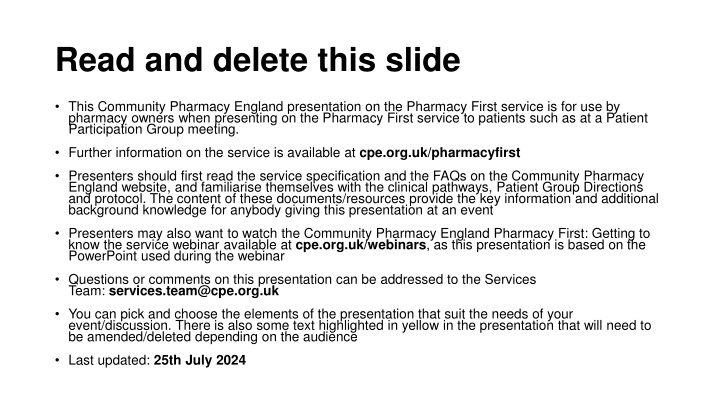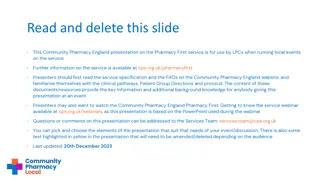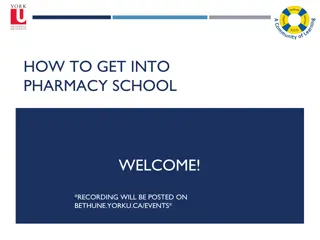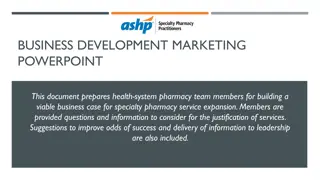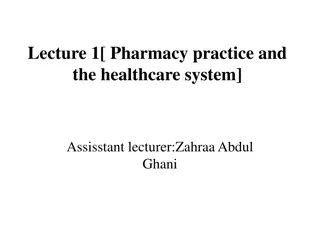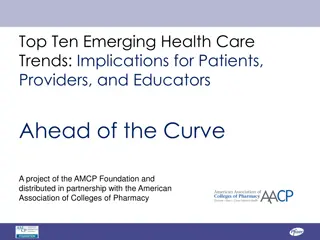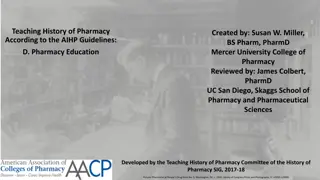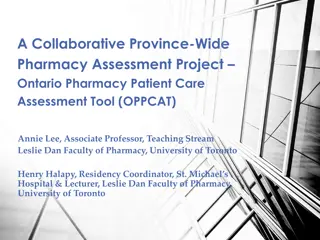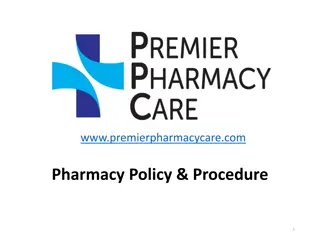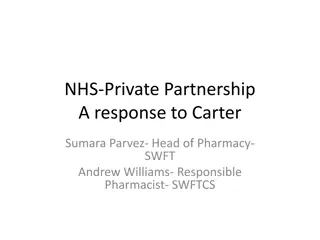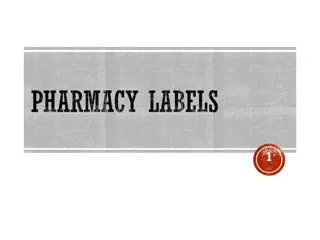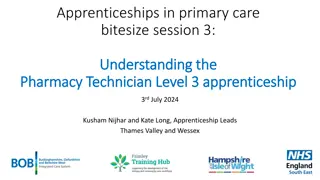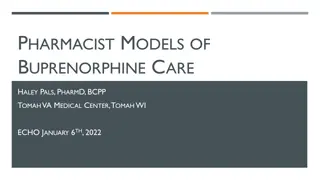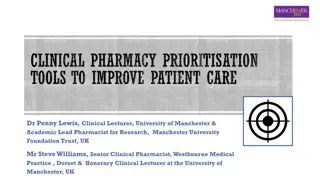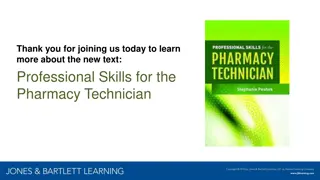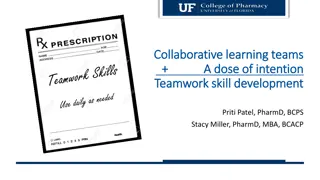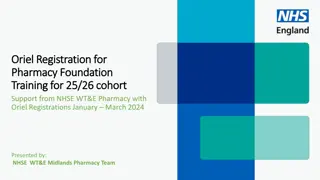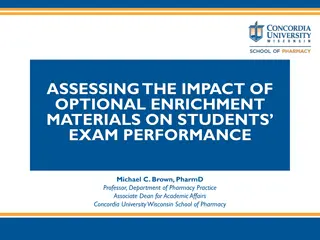Pharmacy First Service Presentation Overview
This presentation provides guidance for pharmacy owners on presenting the Pharmacy First service to patients, including details on service specification, FAQs, clinical pathways, and more. It covers the introduction, animation of the service, how it works, involvement of pharmacists and their teams, and other services available in community pharmacies. The service started on January 31, 2024, as an optional service that most pharmacies in England have adopted, building on the NHS Community Pharmacist Consultation Service (CPCS).
Download Presentation

Please find below an Image/Link to download the presentation.
The content on the website is provided AS IS for your information and personal use only. It may not be sold, licensed, or shared on other websites without obtaining consent from the author.If you encounter any issues during the download, it is possible that the publisher has removed the file from their server.
You are allowed to download the files provided on this website for personal or commercial use, subject to the condition that they are used lawfully. All files are the property of their respective owners.
The content on the website is provided AS IS for your information and personal use only. It may not be sold, licensed, or shared on other websites without obtaining consent from the author.
E N D
Presentation Transcript
Read and delete this slide This Community Pharmacy England presentation on the Pharmacy First service is for use by pharmacy owners when presenting on the Pharmacy First service to patients such as at a Patient Participation Group meeting. Further information on the service is available at cpe.org.uk/pharmacyfirst Presenters should first read the service specification and the FAQs on the Community Pharmacy England website, and familiarise themselves with the clinical pathways, Patient Group Directions and protocol. The content of these documents/resources provide the key information and additional background knowledge for anybody giving this presentation at an event Presenters may also want to watch the Community Pharmacy England Pharmacy First: Getting to know the service webinar available at cpe.org.uk/webinars, as this presentation is based on the PowerPoint used during the webinar Questions or comments on this presentation can be addressed to the Services Team: services.team@cpe.org.uk You can pick and choose the elements of the presentation that suit the needs of your event/discussion. There is also some text highlighted in yellow in the presentation that will need to be amended/deleted depending on the audience Last updated: 25th July 2024
The Pharmacy First Service [Name of presenter]
Presentation overview Introduction Animation of the service How the service works Pharmacists and their teams Other services provided in community pharmacies Q&A
The Pharmacy First service The service started on 31st January 2024 It is an optional service for pharmacies to provide but over 95% of pharmacies in England have signed up to provide the service Builds on the previous NHS Community Pharmacist Consultation Service (CPCS)
Animation of the service [Delete this text before presenting You can show the patient focused animation at meetings directly from YouTube, but if you need access to a downloadable version, please email: comms.team@cpe.org.uk] Watch the animation at https://www.youtube.com/watch?v=ec- 43uOnzPY Two shorter clips are also available on YouTube: How the Pharmacy First service works The value of the Pharmacy First service
How the service works If you have a minor illness, your GP surgery can electronically refer you to a pharmacy of your choice You can also be referred by NHS 111 (online or telephony), an out of hours service, 999 or urgent emergency care settings, e.g. A&E The pharmacist will have a consultation with you In a private consultation room in the pharmacy; or Remotely via a telephone/video consultation (dependent on symptoms/availability of video equipment) With your consent, they will check your GP record or other clinical record
How the service works Advice will be provided and if appropriate, a medicine will be recommended for you to buy or If you have certain symptoms of one of seven conditions and fall within an age category, you may be offered an NHS medicine to treat your condition NHS prescription charges apply if you normally pay for medicines supplied on prescriptions An electronic message will be sent to your GP surgery so your GP health record can be updated If the pharmacist cannot help you, you will be directed to your GP surgery or other healthcare professional as appropriate
What are the seven conditions? Sinusitis Sore throat Infected insect bite 1 year and over Acute otitis media 1 to 17 years 12 years and over 5 years and over Impetigo Shingles Uncomplicated UTI Women 16 to 64 years 1 year and over 18 years and over
How the service works If you have certain symptoms of one of the seven conditions and fall with the age category, you can also walk into your pharmacy (self refer) and access the service You may be seen by another trained member of staff first who can triage you to see if your symptoms are typical of the seven conditions and then refer you to the pharmacist if appropriate If you have symptoms which mean you are eligible for the service, an electronic message will be sent to the GP surgery so your GP health record can be updated
Protocols that pharmacist must follow Pharmacists must follow strict protocols for the seven conditions that are included in Pharmacy First They cannot deviate from these, so if you do not meet the inclusion criteria, the pharmacist cannot provide you with NHS medicines such as antibiotics You may be asked to return to the pharmacy after a period of time for the pharmacist to reassess your symptoms to see if it would then be appropriate for them to supply you with an NHS medicine or refer you to another healthcare professional
Supply of urgent medicines or appliances There is another strand to the service which allows pharmacists to supply medicines or appliances to patients who urgently require them You must be electronically referred, patients cannot walk-in (self-refer) for this strand of the service GP practices cannot refer patients for this strand of the service Electronic referrals can be sent from NHS 111 (online or telephony), an out of hours service, 999 or urgent emergency care settings, e.g. A&E Once a referral has been sent to your choice of pharmacy, you should be advised to phone the pharmacy to speak to the pharmacist
Supply of urgent medicines or appliances The pharmacist will check for a referral message and then have a consultation with you on the phone (or face-to-face if the patient chooses to visit the pharmacy instead) You will be interviewed to assess the suitability of an emergency supply of your medicine or appliance and your eligibility to use the service With your consent, they will check your GP record or other clinical record
Supply of urgent medicines or appliances If suitable and the pharmacy has the medicine or appliance in stock, they can make a supply NHS prescription charges apply if you normally pay for medicines supplied on prescriptions If not suitable or the pharmacy does not have the medicine or appliance in stock, the pharmacist should organise support from another healthcare professional for you An electronic message will be sent to your GP surgery so your GP health record can be updated
Pharmacists and their teams Pharmacists are experts in medicines and minor health conditions As part of their training, they undergo a four-year degree and a foundation training year (where they work as a trainee pharmacist in a pharmacy, hospital or other appropriate location) Pharmacists have been provided with lots of support to upskill and give them the confidence to offer this service Other members of the pharmacy team also have relevant qualifications for their roles to ensure they are appropriately trained to offer health advice
Other services provided in pharmacies While you are at your pharmacy, why not ask about other services that they provide Many pharmacies now provide the following NHS services: Blood pressure checks service A service aimed at patients aged 40 years and above Pharmacy contraception service Initiation and provision of an on- going supply of oral contraception Flu vaccination service New Medicine Service provides support to patients with long-term conditions newly prescribed certain medicines
